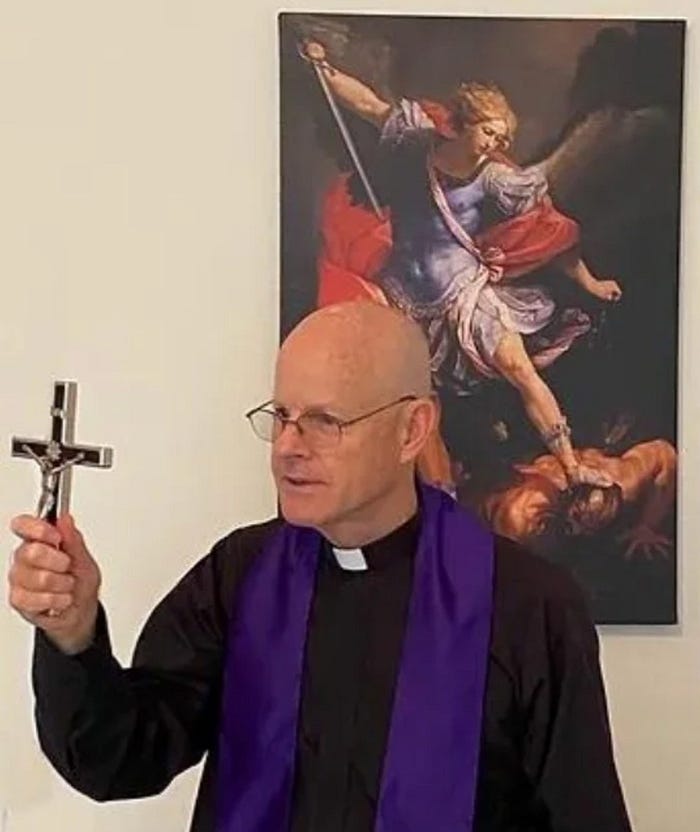Satanic Panic is Alive and Well in Southern Maryland
How a talk about historical witchcraft ignited centuries-old prejudices and bigotry
Well, I sure didn’t expect to set off satanic panic!

In the lead-up to my talk on witchcraft (The History and Reality of Witchcraft in America) for the St. Mary’s County Historical Society in Leonardtown Maryland last weekend — which detailed the region’s dark history of witch hunts and executions in the colonial period — I caught wind of some disturbing happenings.

In the week before the event, a gaggle of concerned local Christians — close to a dozen, I am told — invaded a local bookstore. They looked around, found some tarot decks (!) and crystals (!) for sale, and promptly started praying aloud and throwing salt and holy water around the premises.
Having apparently exorcised any lingering demons, they quickly beat feet and departed, leaving the clerk shocked (and probably annoyed that she had to vacuum up the salt).
Apparently this year, some of the more superstitious Catholics and other alarmed Christian folks got their underpants in a twist about the celebration of Moll Dyer Day, which I wrote about in my last newsletter (and you can check out in the video below).
Moll Dyer Day has become a popular attraction, bringing people from across the state and the country to lovely, historic Leonardtown. The goal of the event is to illuminate history, celebrate local folklore, and also to teach the value of kindness— “Be kind” is the motto, and that simple admonition is plastered on all the banners and promotional materials around town.
Kids and families roam about on a treasure hunt, downtown businesses celebrate with Moll Dyer-themed drinks, and it brings locals and tourists to Leonardtown in what is normally a slow, wintry lull. I have attended for two years now, and look forward to it every February.
This year, however, a tiny but loud minority apparently missed the memo about being kind.
I learned that local Catholic Churches were warning their parishioners to avoid participating in any events related to the accused witch, for fear of the evils of witchcraft “harming the youth” and bringing “darkness” onto St. Mary’s County (ironically considered the birthplace of religious tolerance in the United States — keep that in mind).
I had to wonder: Had I slipped through a time vortex back to the 1980s?
Then a local pagan (closeted, sadly, as he is not comfortable being out about his spiritual beliefs) let me know the source of the panic:
The church folk had googled me 😁

(A concerned friend asked if I worried about having holy water thrown on me during my talk. I decided I would do my best Linda Blair impersonation if, indeed, that did happen.)
I was also alerted to a blog post from Leonard Wathen, director of religious education at St. Aloysius in Leonardtown, about Moll Dyer, which you can read here. I hope you will take a minute or two to read it.
While there are commendable points made about the horror of the historical witch hunts and the need for kindness, religious tolerance, and mercy by Wathen — who may be related to Moll Dyer, he says — ultimately, and sadly, the message turns into the usual prejudiced maligning of witchcraft, magic, and divination.
In the post, Wathen provides a link to a story of an exorcism by Msgr. Stephen J. Rosetti, an exorcist from the Archdiocese of Washington who runs the nonprofit St. Michael Center for Spiritual Renewal.
(As I was named after St. Michael, I’ve always felt an affinity for him, and have a reproduction icon of him on my desk.)
This anecdote, Wathen suggests, should read by the faithful as a cautionary tale about the power of witchcraft to seduce the unwary. Take a moment and read it, too.

This account from the monsignor, however, did not pass the sniff test.
“Sarah’s” mother was a high-ranking satanic priestess who introduced her daughter to the practice of witchcraft when she was very young. Sarah said each week six witches gathered to curse priests and the bishops by name. They sat around an effigy of the priest and ritually cursed him. She added that there were many covens in her area and all were weekly cursing different priests.
I’m sorry, that is 100% unadulterated bullshit.
Modern witches, the vast majority of whom do not worship or even believe in Satan, are not spending their precious time (every week!) cursing effigies of priests and bishops. This is a perverse confabulation conjured by someone stuck in the era of Michelle Remembers.
In fact, if one were cynical, one might believe this hysterical satanic panic reboot is designed to avert attention from demonic perversities such as those chronicled in the 456-page report recently completed by the Maryland Attorney General’s Office implicating 158 priests within the Archdiocese of Baltimore accused of sexual abuse and torture of more than 600 victims — many of them children.
The Archdiocese, of course, has fought tooth-and-nail to keep the report secret.

As someone who was brought up Catholic (and even confirmed!), I am not anti-Catholic by any means. I love soaking up the ambience of historical churches and had my first introduction to magic and mysticism during the celebration of the Mass as a child, entranced by the candles, icons of the saints, the chants and prayers, the rituals of the priest at the altar, and the intoxicating scent of frankincense and myrrh.
As I grew older, I became disenchanted with many aspects of Catholic dogma, which led me to leave the organization, but, as I discovered recently when attending a funeral Mass for a friend, I still know every word of the liturgy by heart. You can’t erase that sort of programming.
But as I read about the history of religion over these past decades, I came to understand that there are countless ways to approach divinity — including methods that do not require a hierarchy of intermediaries.
You can, I discovered, connect with divinity — however you define it — in your own way and on your own terms.
I also learned that early Christians performed magic and divination, just like members of every other religion — Judaism, Buddhism, Taoism, Islam, Hinduism — before their priests clamped down on those practices.

I discovered that many Catholics still practice various forms of folk magic — all of it within an explicitly Christian context. And that folk traditions from across the world utilize prayers to Jesus, Mary, and the saints. These people are not satanists, whether or not Orthodox authorities approve of their activities.
I learned that tarot cards — maligned by modern Catholics like Wathen as dangerous and diabolical tools of Satan — are absolutely loaded with Catholic themes and iconography, because they originated as a game in Catholic Italy in the 15th century.
And that even the ubiquitous Smith-Waite “occult” deck, is chock-full of Catholic symbolism, like this Ace of Cups with the Holy Spirit/Paraclete descending with the consecrated host into the chalice.

Which is not at all surprising, given that Arthur Edward Waite, who conceived the deck, and the artist, Pamela Colman Smith, were both Catholics, albeit of the more esoterically inclined variety.
There are even books that utilize a Christian approach to tarot cards for insight and Christian mystical contemplation (Meditations on the Tarot, in fact, was endorsed by Catholic Bishop Hans Urs von Balthasar).
There is much that could be learned by Catholics, pagans, witches, folklorists, academics, historians, and believers and non-believers of all sorts through respectful, open, interfaith dialogue rooted in history, religious studies, anthropology, and folklore.
Especially around powerful legends like that of Moll Dyer.
That’s why I talk about these subjects—to facilitate conversations and allow us all to learn from one another.
Sadly, it appears some elements in the Catholic Church have forgotten the beautiful, enduring message of Jesus — of love, tolerance, and forgiveness — and retreated into the fear and bigotry many of us hoped we had left behind in the 17th century.
The same sort of fear and bigotry that led to women like Mary Lee (1654) and Elizabeth Richardson (1659) being hanged on ships en route to St. Mary’s after being accused of witchcraft by superstitious sailors. Their bodies and possessions were thrown into the Atlantic like so much garbage before the ship arrived on the Maryland shore.
The same fear and bigotry that led to Rebecca Fowler being the first woman hanged for witchcraft in Maryland in 1685.
And yes, the same fear and bigotry that burned Moll Dyer’s home and left her to freeze to death in the brutal winter night.

Instead of whipping up fear and hysteria about nonexistent “satanic” witches intent on stealing the innocent souls of their children, maybe the Catholics and Christians of Leonardtown and St. Mary’s County who are so fearful of Moll Dyer Day should instead look deep inside at their own community’s demons — demons that, unlike the fictitious satanic witches based on medieval superstition, are very real and very dangerous.
Those demon-haunted monsters walk among us today, in the flesh, having done very real and irreperable physical and emotional harm to children. And far too often, they are being sheltered and hidden by the pious haunting the pews, offices, and rectories.
The church’s exorcists should not be making up patently ridiculous stories about covens of satanic witches cursing their effigies and preying upon innocent children — especially when that Church has brought a damning generational curse upon itself. A curse yet to be lifted.
The exorcisms shouldn’t be be taking place in bookstores, but within the churches, the offices of the Archdiocese, and the hearts of the faithful who refuse to acknowledge historical and ongoing abuse of innocent lives.
The demons rooted in the institution of the Catholic Church need to be exorcised until there is a full and public accounting and atonement for the countless lives corrupted and violated by predatory priests and clergy, and full contrition of the—let’s call it what it is—diabolical coverup perpetuated by those in power.
In the meantime, I hope everyone else can reflect and learn from the centuries of fear, hypocrisy, bigotry, and persecution that led to witch hunts and the murder of innocent people, and take the lessons of Moll Dyer Day to heart. Visit Leonardtown, take part in Moll Dyer Day, and show the sad, frightened minority that love and kindness triumph over narrowmindedness.
Be kind. Don’t be afraid of things you don’t understand. Look honestly at what you fear, and do not let irrational fears lead you to acts of violence and abuse.
And when you find demons within yourself, be honest and exorcise those monsters from within, rather than projecting them onto others.

Michael M. Hughes is a writer, speaker, and magical thinker. He is the author of Magic for the Resistance: Rituals and Spells for Change as well as numerous other works of fiction and nonfiction, and he speaks and teaches classes on magic, tarot, psychedelics, and more.
His comprehensive tarot course, The Art and Magic of the Tarot: Foundations, is available here (and makes a great gift!). Upcoming classes include Tarot Magic, Going Pro with Tarot, Introduction to the I Ching, and other magical topics.
His work has been featured in The New York Times, The Boston Globe, CNN, The L.A. Times, Rolling Stone, Comedy Central, Wired, Elle, Vox, Cosmopolitan,and even the ultraconservative The American Spectator, which wrote: “He may play footsie with the devil, but at least the man has a sense of humor.”
You can sign up for his newsletter and follow him on YouTube, Twitter (at least for now), Mastodon, Facebook, and Instagram.
